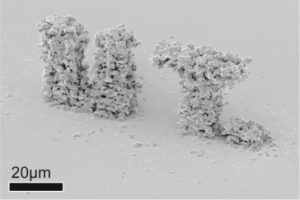Researchers at the University of Twente have developed a new laser printing technique that allows for the 3D printing of gold nanostructures, including complex overhanging structures. By pointing a very short laser pulse onto a nanometer-thin metal film, a tiny droplet of liquid metal is ejected onto the substrate, where it solidifies. The technique is called laser-induced forward transfer, or LIFT. The researchers have been using it to build tiny, complex structures out of copper and gold; the copper acts as a mechanical support for the gold.
LIFT will enable the 3D printing of micro components for electronics or photonics. The example that the researchers use is a tiny helix, which could act as a mechanical spring or an electrical conductor at the same time. The helix is printed with copper around it, forming a copper box, which prevents a drop meant for a new winding from landing on the previous winding. After the helix is completed, the copper is etched away chemically, leaving a helix of pure gold, just a few tens of microns in size.
The volume of the droplets is a few femtoliters, and have the diameter of a little more than one nanometer. A short pulse of green laser light is used to melt the gold and copper. The researchers were concerned that the two metals would mix, but that wasn’t the case. The drop by drop method used to build the microscopic structures results in high resolution, with a surface roughness of only 0.3 to 0.7 microns.
The research is documented in a paper entitled “Printing of complex free-standing microstructures via laser-induced forward transfer (LIFT) of pure metal thin films.”
“The further reduction of Au porosity will be the topic of future work, for instance through laser re-melting, conventional sintering or better understanding of the droplet impact behavior,” the researchers state. “Also, heating of the receiver could reduce thermal stresses and possibly splashing of droplets. Smaller structures could be achieved through minimizing stress on small features, e.g. through critical point drying, more precise sample manipulation and smaller droplet sizes. This study demonstrates that LIFT can be used for functional 3D printing with very small features and using pure materials which is important for use in electronics or micromechanics.”
 The LIFT technique can also be used for other metals or combinations of metals. It has a lot of potential for use in applications such as electronic circuits, micromechanical devices and sensing for biomedical applications. Using copper as a “sacrificial” material allows for more complex structures to be 3D printed, such as those with overhangs, like the helix. This technique, like other additive manufacturing techniques, has the potential to save time and money while allowing for the production of intricate components.
The LIFT technique can also be used for other metals or combinations of metals. It has a lot of potential for use in applications such as electronic circuits, micromechanical devices and sensing for biomedical applications. Using copper as a “sacrificial” material allows for more complex structures to be 3D printed, such as those with overhangs, like the helix. This technique, like other additive manufacturing techniques, has the potential to save time and money while allowing for the production of intricate components.
The research was carried out by the departments of Mechanics of Solids, Surfaces and Systems (MS3) and Design, Production and Management (DPM), both part of the Engineering Technology faculty of the University of Twente. The researchers also collaborated with DEMCON Corporation, a spinoff company of the University of Twente.
Authors of the paper include Matthias Feinaeugle, Ralph Pohl, Ton Bor, Tom Vaneker and Gert-willem Römer.
Discuss this and other 3D printing topics at 3DPrintBoard.com or share your thoughts below.
Subscribe to Our Email Newsletter
Stay up-to-date on all the latest news from the 3D printing industry and receive information and offers from third party vendors.
You May Also Like
Immensa and Pelagus 3D Collaborate to Tap “$2 Billion” 3D Printing Opportunity
Dubai’s Immensa, which claims to be the “largest digital manufacturer” in the Middle East/North Africa (MENA) region, has formed a strategic collaboration with Pelagus 3D, a Singapore-based, on-demand digital manufacturing...
US Army Contracts 3YOURMIND & Phillips Corp. for 3D Printed Tank Parts Identification
The US Army Combat Capabilities Development Command (DEVCOM) Ground Vehicle Systems Center (GVSC) has awarded 3YOURMIND and Phillips Corporation Federal Division a contract to develop part identification solutions for tanks....
Manufacturing World Tokyo 2024 Set to Showcase Innovation in AM, 3D Printing and More!
After the success of its Nagoya leg last April, Manufacturing World Tokyo 2024, one of Asia’s premier manufacturing exhibitions, is gearing up for its second leg this year, returning to...
3D Printing Webinar and Event Roundup: May 19, 2024
This week, Stratasys continues its advanced training and starts its Experience Stratasys tour across the United States. ASTM’s AMCOE continues its professional certificate course, and SPE is offering a workshop...



































